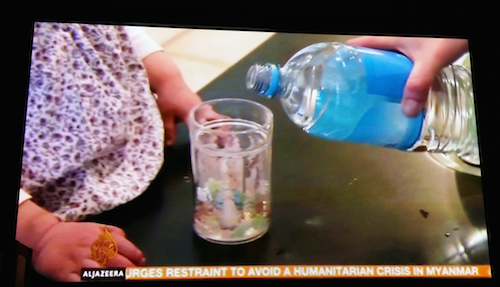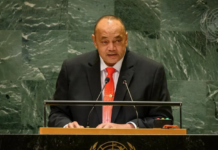Al Jazeera’s People & Power programme investigates disturbing claims that New Zealand’s rivers and lakes are among the most polluted in the developed world. This is a major issue in the country’s general election on September 23.
BACKGROUND: Naashon Zalk reports on his two-part documentary
I had lived in New Zealand for two years in the early 2000s. In 2015, I moved back here. And I was astonished to see how much the country had changed in those 15 years.
It has become wealthier on the back of an urban property boom, mass immigration and the explosive growth of intensive dairy farming which began back in the 1990s.

I also discovered that the country is harbouring a disturbing secret, little known to the rest of the world: its freshwater is in severe crisis. Two-thirds of New Zealand’s rivers are too polluted to swim in and half its lakes are irreversibly damaged.
This pollution, say many independent environmentalists, scientists and economists, is primarily a by-product of the laissez faire growth of the country’s dairy industry. The government, dairy industry, and irrigation lobby disagree. They say it’s a legacy of over 100 years of farming.
I set out to investigate why New Zealand, a country which markets itself as a clean, green paradise, has in fact got disturbing water pollution problems which only appear to be getting worse.

While I was researching the story an event happened which I believe has been pivotal in awakening New Zealanders to the dire state of their freshwater. In August 2016, the tiny town of Havelock North, on the east coast of the country’s North Island, was incapacitated by an outbreak of campylobacter in their drinking water.
More than 5000 of its 15,000 inhabitants were made ill by the bug and three deaths were later linked to the outbreak.
Bigger pertinent story
Upon investigating the Havelock North water poisoning I was alerted to an even bigger, and more pertinent story in the wider Hawke’s Bay area.
The regional council had been striving for years to get a controversial billion-dollar irrigation scheme off the ground, called the Ruataniwha Water Storage Scheme. But as I found, local and national opposition to the dam, especially after the Havelock North contamination outbreak, was becoming more vocal.
I quickly realised that this was a crucial part of the story. The growth of New Zealand’s highly profitable dairy industry has, to a large extent, been made possible by irrigation schemes which deliver the massive volumes of water needed to produce milk.

Every litre of milk produced requires about 1000 litres of water. The most irrigated region of New Zealand is Canterbury, on the east coast of the country’s South Island. It has seen significant economic growth on the back of dairy farming but, over the same period of time, has also seen a drastic decline in the quality of its waterways.
Opponents of the dam in Hawke’s Bay were worried that the same environmental degradation would take place in their region if it went ahead.
They were also concerned that the council, hell-bent on the scheme, were ignoring glaring flaws in the dam’s business case.
A regional election, coming only a month after the Havelock North debacle, was gearing up to become a referendum on the dam and it gave me the perfect vehicle to explore the arguments. At the time, the nine-member council was divided between five pro- and four anti-dam representatives.
All it would take to thwart the dam was for anti-dam councillors to win a single seat. And the winning of that seat would have national repercussions, because the Ruataniwha project was seen as the poster child for other planned irrigations schemes, most of them along New Zealand’s drought prone east coast.
Eager to understand their vastly opposing views I followed the election campaigns of two local politicians.
‘Can the Dam’ campaign
Alan Dick, a regional councillor, was one of the dam project’s originators. The other, Paul Bailey, is a former bank manager turned Green Party politician. He was running for office for the first time under the slogan “Can The Dam”.
On the surface, the arguments of the pro-dam lobby sounded very reasonable. I was told the dam would alleviate drought concerns, boost economic growth and improve the quality of rivers it fed into by flushing away pollution.
In tandem with constructing the dam, much stricter environmental regulations would come into play to keep contamination below an environmental limit which was set by the Environmental Protection Agency.
But as I investigated further I found what seemed to be serious flaws in their arguments. And indeed, upon examination, the commercial case for the dam didn’t seem to add up either.
As you’ll see, these are documented in the first film – and continue into the second episode in which I also look at allegations of high-level political interference in the project and other related issues.
Over the many months, I’ve spent investigating this story, anxiety and anger about freshwater pollution has grown to make it New Zealand’s top environmental concern – and now, reflecting many of the same arguments I’d encountered in Hawke’s Bay, it’s also become a key issue in the country’s current and ongoing general election campaign, which reaches a climax on September 23.

Barely a day goes by without the problem being reported in the media here and seemingly everyone has an opinion – whether they be environmentalists arguing for a better way of managing a vital natural resource or dairy farmers who are angry at what they see as grossly unfair criticism of their role in the crisis.
The fury of the latter – and they are a powerful lobby in New Zealand – was brought home to us several times on location when our attempts to film generic roadside shots of dairy cattle were interrupted by the animals’ suspicious owners.
My main hope is that some of the questions raised by these films will contribute to the debate around New Zealand’s freshwater problems – problems that all agree will have to be addressed by whichever party takes office after the election.
One thing is certain, urgent action on pollution cannot be delayed.
Editor’s note: Last week, on August 30, as these two Al Jazeera documentaries were being prepared for broadcast, Hawke’s Bay Regional Council announced it was withdrawing support for the Ruataniwha dam, leaving the project’s future in some doubt. Nevertheless, with the current New Zealand National Party-led coalition government and many in the powerful dairy industry continuing to be strong supporters of irrigation schemes, it may be too soon to write the scheme off entirely.












































